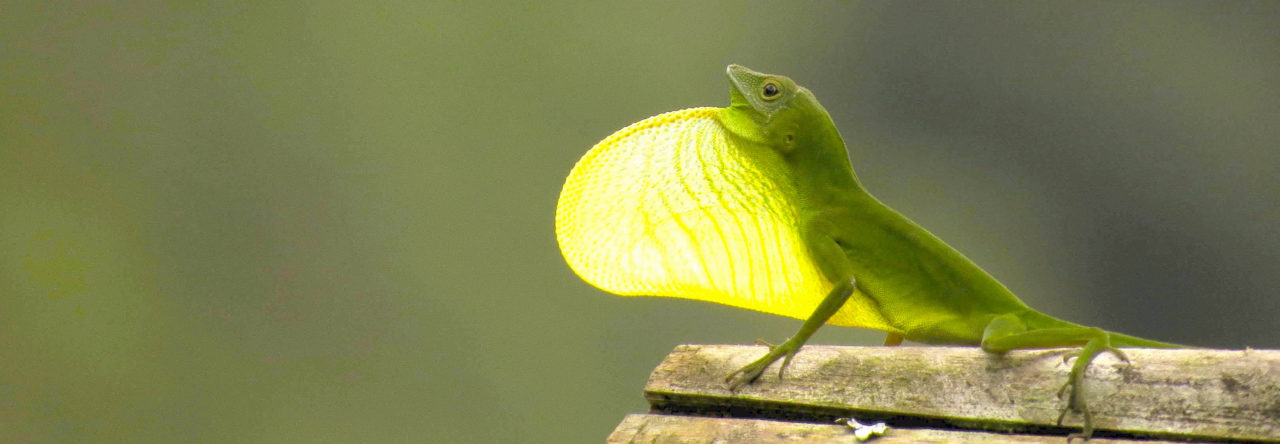Greetings anole biologists and enthusiasts! I write to you from Fred Janzen’s 30-year field site along the Mississippi River in northwest Illinois, where I’m collecting data for my dissertation studies. Unfortunately, there aren’t any anoles here, but the painted and common snapping turtle densities are impressive. Fortunately for this post, however, current field work has been paused as a team of inmates are cleaning up debris from recent flooding of the area. Thus, I’ll give a brief update on the last chapter of my master’s research with Dan Warner and the brown anoles* of northeastern Florida.
A good bit of Anolis work has shown that species partition perch height and width to reduce competition. However, less work has focused on habitat partitioning within species of anoles. Thus, my thesis work examined whether similar partitioning exists between age and sex classes of the brown anole, and attempted to identify the drivers and mechanisms of such age-specific habitat use. First, we found that juveniles on Dan’s study islands perch on lower and thinner perches, and use the ground more frequently, than adults (discussed in another Anole Annals post). We then altered the density of adult males in mesh enclosures in the lab, and found that juveniles perch lower in the presence of adult males and have a greater response as adult male density increases (discussed in another Anole Annals post also).

Juvenile Anolis sagrei survival in response to adult male and female density (F4, 164 = 3.67, P = 0.0069).
Quite excited by our findings that adult male density influences juvenile microhabitat choice, we set up two field experiments to assess 1) how adult male and female densities independently affect juvenile microhabitat use and survival, and 2) how juvenile presence affects adult male and female microhabitat use. Interestingly, we found that after just four days of exposure, adult male, but not female, presence reduced juvenile survival (Fig 1). However, we found no evidence that juveniles shifted microhabitat use behaviorally, nor were juveniles selected against in a pattern consistent with the observed age-specific habitat use in the field (e.g., selection favoring low perching juveniles) in response to either adult males or females. One large difference between the lab and field experiments is that the lab experiment used larger juveniles than the field experiment. Perhaps the smaller field juveniles innately perched in safe microhabitats, thus reducing their ability to behaviorally respond to adult threats. In addition, strong past selection favoring low perching hatchlings may have reduced the phenotypic variation needed to detect any selective patterns. The second field experiment revealed that adult microhabitat use is not affected by the presence of juveniles.
This last chapter has recently been published and is freely available through this link until 25 July 2017 (Delaney and Warner. 2017. Animal Behaviour 129:31-41). After that, shoot me an email.
For now, I’ll be studying fitness tradeoffs in maternal investment strategies in turtles. However, once an anologist, always an anologist. So I’ll keep an eye on Anole Annals to get my Anolis fix, until I find my way back south.
Happy noosing!
*Note – I’m certain that “Dan Warner and the Brown Anoles” should be a band name.
- SICB 2018: When the Lights Go Up in the City - January 9, 2018
- SICB 2018: Moms Help Embryos Beat the Heat - January 8, 2018
- Effects of Age- and Sex-specific Density on Behaviour and Survival of the Brown Anole - June 11, 2017



Ambika Kamath
This is super interesting! Do you think the reduced survival was a consequence of direct predation, or of competition, or both? Also, agreed on the band name 🙂
David Delaney
Thanks, Ambika! We saw a few adults in the act of consuming juveniles and a few adults that looked especially plump after a juvenile had gone missing. Some juveniles were found dead in the enclosure that probably died because of competition. Unfortunately ants quickly broke down anything that died on the island so we couldn’t confirm missing individuals as cannibalized vs died from other causes. Given how short the exposure time was, it would have been nice to set up a camera to review after juveniles disappeared.